Strategic HRM Theories and Practices Report: Gucci & Zara Analysis
VerifiedAdded on 2020/11/23
|8
|2607
|55
Report
AI Summary
This report provides a comprehensive analysis of strategic Human Resource Management (HRM) theories and practices, focusing on the fashion industry giants, Gucci and Zara. It begins by outlining the HR policies and practices implemented within these organizations, including regulatory policies, paid time off, leave policies, and flexible working hours. The report then delves into the strategic HRM approaches employed, such as high commitment HRM and best-fit HRM, and explores the product life cycle model within the context of Gucci and Zara. Furthermore, it examines the impact of various external factors, including the employment market, political factors, technological advancements, and workforce demographics, on the HR strategies of these companies. The report also details how HR functions are organized and delivered, with a specific focus on the roles and challenges faced by line managers in implementing HR policies. Through this analysis, the report offers insights into the complexities of strategic HRM and its practical application in the competitive fashion industry. This report is available on Desklib, which is a platform that offers past papers and solved assignments for students.
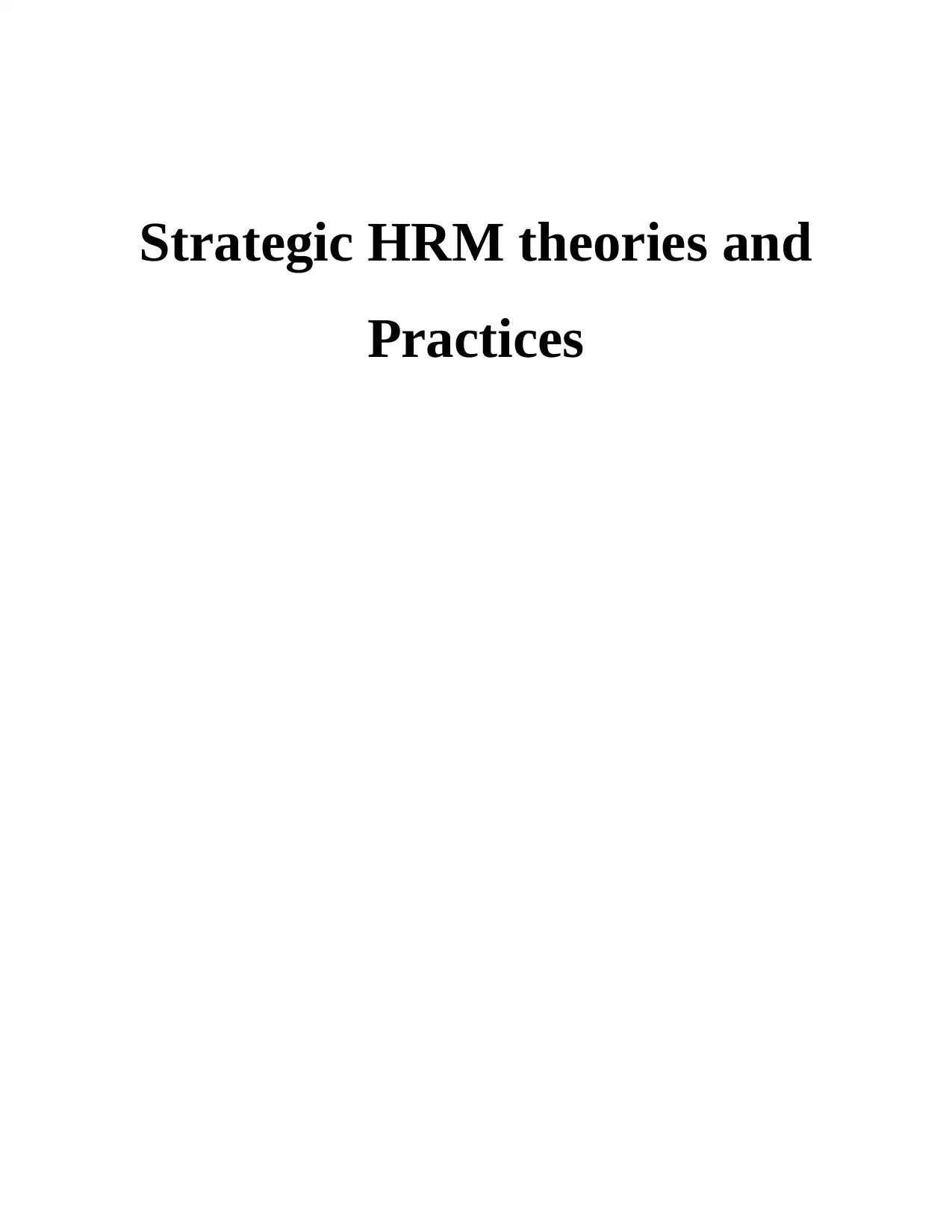
Strategic HRM theories and
Practices
Practices
Paraphrase This Document
Need a fresh take? Get an instant paraphrase of this document with our AI Paraphraser
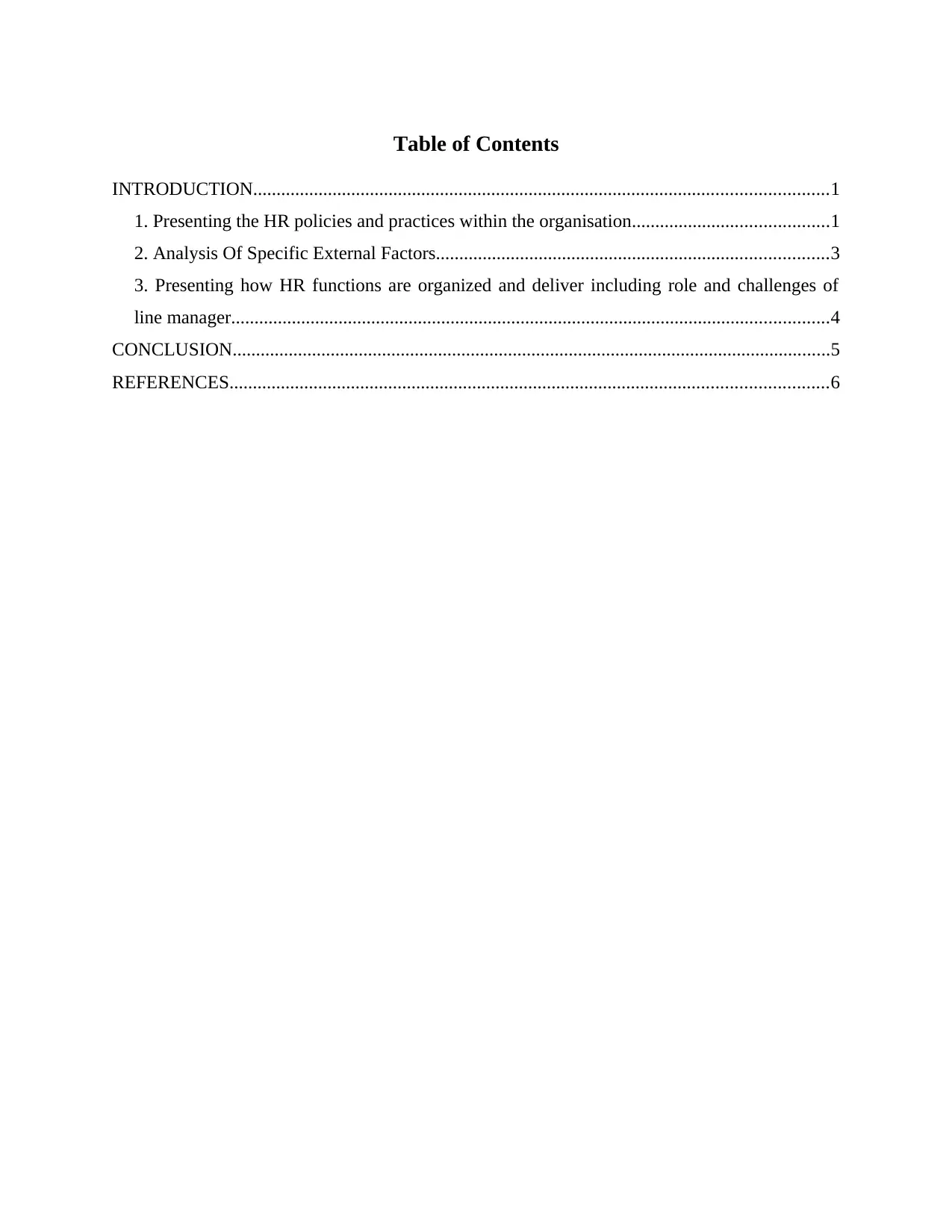
Table of Contents
INTRODUCTION...........................................................................................................................1
1. Presenting the HR policies and practices within the organisation..........................................1
2. Analysis Of Specific External Factors....................................................................................3
3. Presenting how HR functions are organized and deliver including role and challenges of
line manager................................................................................................................................4
CONCLUSION................................................................................................................................5
REFERENCES................................................................................................................................6
INTRODUCTION...........................................................................................................................1
1. Presenting the HR policies and practices within the organisation..........................................1
2. Analysis Of Specific External Factors....................................................................................3
3. Presenting how HR functions are organized and deliver including role and challenges of
line manager................................................................................................................................4
CONCLUSION................................................................................................................................5
REFERENCES................................................................................................................................6
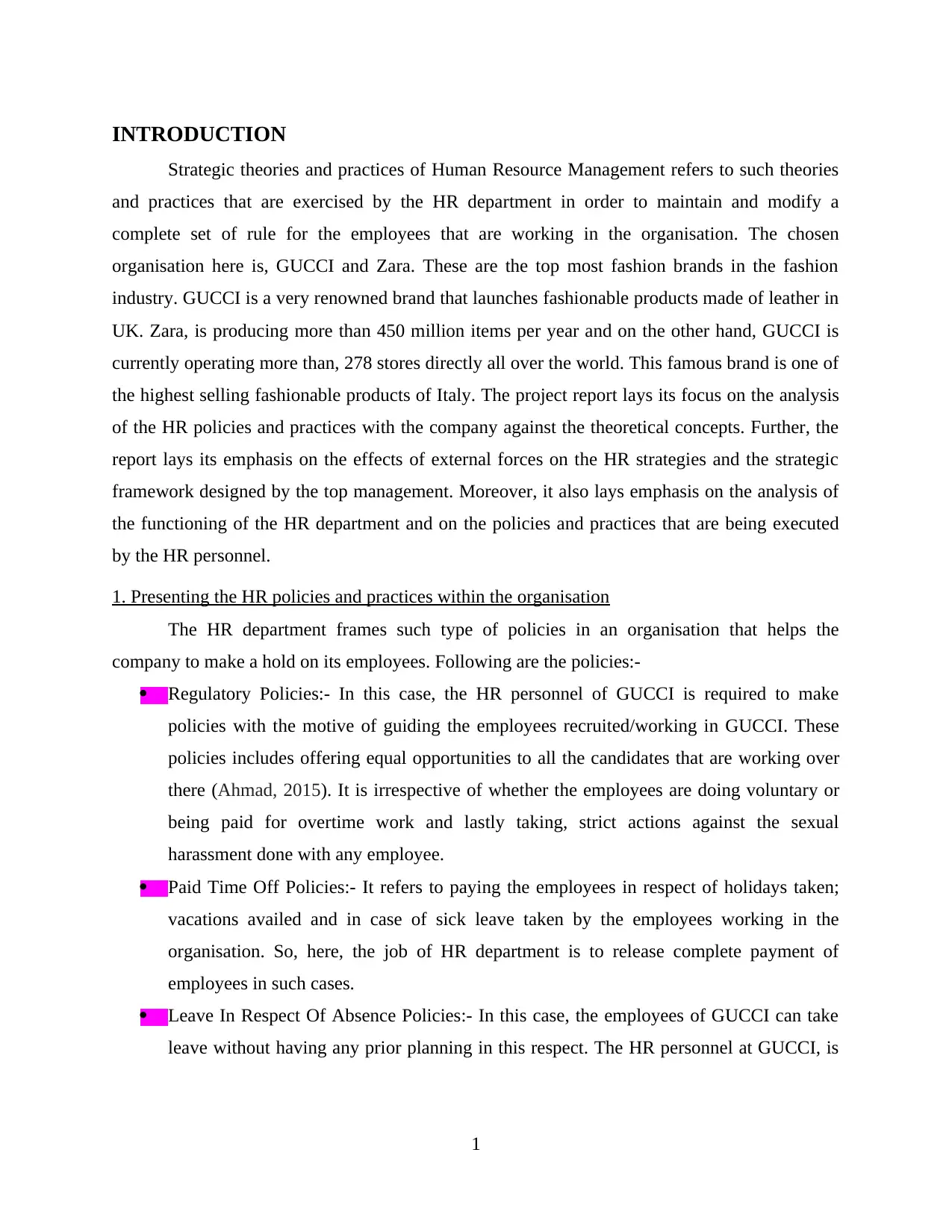
INTRODUCTION
Strategic theories and practices of Human Resource Management refers to such theories
and practices that are exercised by the HR department in order to maintain and modify a
complete set of rule for the employees that are working in the organisation. The chosen
organisation here is, GUCCI and Zara. These are the top most fashion brands in the fashion
industry. GUCCI is a very renowned brand that launches fashionable products made of leather in
UK. Zara, is producing more than 450 million items per year and on the other hand, GUCCI is
currently operating more than, 278 stores directly all over the world. This famous brand is one of
the highest selling fashionable products of Italy. The project report lays its focus on the analysis
of the HR policies and practices with the company against the theoretical concepts. Further, the
report lays its emphasis on the effects of external forces on the HR strategies and the strategic
framework designed by the top management. Moreover, it also lays emphasis on the analysis of
the functioning of the HR department and on the policies and practices that are being executed
by the HR personnel.
1. Presenting the HR policies and practices within the organisation
The HR department frames such type of policies in an organisation that helps the
company to make a hold on its employees. Following are the policies:-
Regulatory Policies:- In this case, the HR personnel of GUCCI is required to make
policies with the motive of guiding the employees recruited/working in GUCCI. These
policies includes offering equal opportunities to all the candidates that are working over
there (Ahmad, 2015). It is irrespective of whether the employees are doing voluntary or
being paid for overtime work and lastly taking, strict actions against the sexual
harassment done with any employee.
Paid Time Off Policies:- It refers to paying the employees in respect of holidays taken;
vacations availed and in case of sick leave taken by the employees working in the
organisation. So, here, the job of HR department is to release complete payment of
employees in such cases.
Leave In Respect Of Absence Policies:- In this case, the employees of GUCCI can take
leave without having any prior planning in this respect. The HR personnel at GUCCI, is
1
Strategic theories and practices of Human Resource Management refers to such theories
and practices that are exercised by the HR department in order to maintain and modify a
complete set of rule for the employees that are working in the organisation. The chosen
organisation here is, GUCCI and Zara. These are the top most fashion brands in the fashion
industry. GUCCI is a very renowned brand that launches fashionable products made of leather in
UK. Zara, is producing more than 450 million items per year and on the other hand, GUCCI is
currently operating more than, 278 stores directly all over the world. This famous brand is one of
the highest selling fashionable products of Italy. The project report lays its focus on the analysis
of the HR policies and practices with the company against the theoretical concepts. Further, the
report lays its emphasis on the effects of external forces on the HR strategies and the strategic
framework designed by the top management. Moreover, it also lays emphasis on the analysis of
the functioning of the HR department and on the policies and practices that are being executed
by the HR personnel.
1. Presenting the HR policies and practices within the organisation
The HR department frames such type of policies in an organisation that helps the
company to make a hold on its employees. Following are the policies:-
Regulatory Policies:- In this case, the HR personnel of GUCCI is required to make
policies with the motive of guiding the employees recruited/working in GUCCI. These
policies includes offering equal opportunities to all the candidates that are working over
there (Ahmad, 2015). It is irrespective of whether the employees are doing voluntary or
being paid for overtime work and lastly taking, strict actions against the sexual
harassment done with any employee.
Paid Time Off Policies:- It refers to paying the employees in respect of holidays taken;
vacations availed and in case of sick leave taken by the employees working in the
organisation. So, here, the job of HR department is to release complete payment of
employees in such cases.
Leave In Respect Of Absence Policies:- In this case, the employees of GUCCI can take
leave without having any prior planning in this respect. The HR personnel at GUCCI, is
1
⊘ This is a preview!⊘
Do you want full access?
Subscribe today to unlock all pages.

Trusted by 1+ million students worldwide
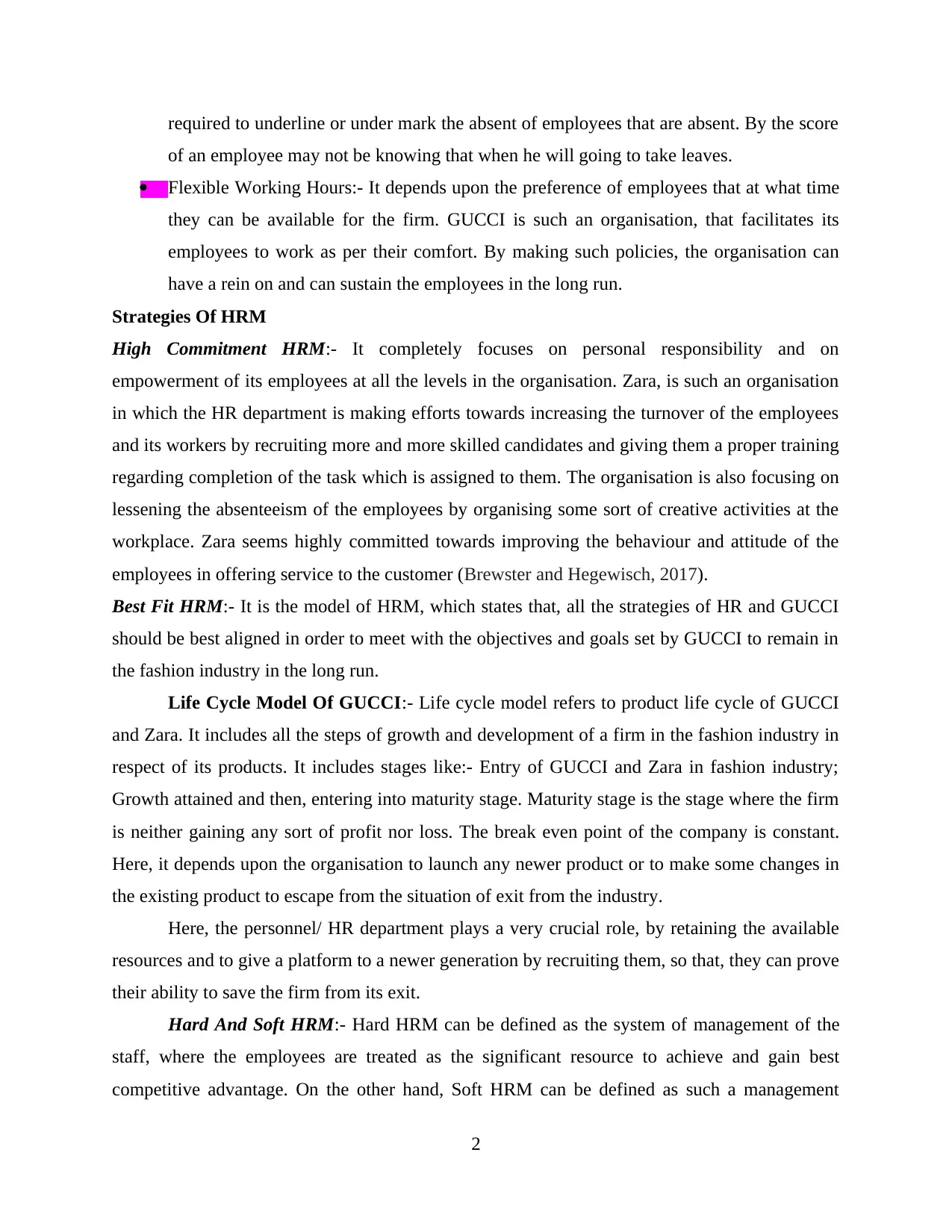
required to underline or under mark the absent of employees that are absent. By the score
of an employee may not be knowing that when he will going to take leaves.
Flexible Working Hours:- It depends upon the preference of employees that at what time
they can be available for the firm. GUCCI is such an organisation, that facilitates its
employees to work as per their comfort. By making such policies, the organisation can
have a rein on and can sustain the employees in the long run.
Strategies Of HRM
High Commitment HRM:- It completely focuses on personal responsibility and on
empowerment of its employees at all the levels in the organisation. Zara, is such an organisation
in which the HR department is making efforts towards increasing the turnover of the employees
and its workers by recruiting more and more skilled candidates and giving them a proper training
regarding completion of the task which is assigned to them. The organisation is also focusing on
lessening the absenteeism of the employees by organising some sort of creative activities at the
workplace. Zara seems highly committed towards improving the behaviour and attitude of the
employees in offering service to the customer (Brewster and Hegewisch, 2017).
Best Fit HRM:- It is the model of HRM, which states that, all the strategies of HR and GUCCI
should be best aligned in order to meet with the objectives and goals set by GUCCI to remain in
the fashion industry in the long run.
Life Cycle Model Of GUCCI:- Life cycle model refers to product life cycle of GUCCI
and Zara. It includes all the steps of growth and development of a firm in the fashion industry in
respect of its products. It includes stages like:- Entry of GUCCI and Zara in fashion industry;
Growth attained and then, entering into maturity stage. Maturity stage is the stage where the firm
is neither gaining any sort of profit nor loss. The break even point of the company is constant.
Here, it depends upon the organisation to launch any newer product or to make some changes in
the existing product to escape from the situation of exit from the industry.
Here, the personnel/ HR department plays a very crucial role, by retaining the available
resources and to give a platform to a newer generation by recruiting them, so that, they can prove
their ability to save the firm from its exit.
Hard And Soft HRM:- Hard HRM can be defined as the system of management of the
staff, where the employees are treated as the significant resource to achieve and gain best
competitive advantage. On the other hand, Soft HRM can be defined as such a management
2
of an employee may not be knowing that when he will going to take leaves.
Flexible Working Hours:- It depends upon the preference of employees that at what time
they can be available for the firm. GUCCI is such an organisation, that facilitates its
employees to work as per their comfort. By making such policies, the organisation can
have a rein on and can sustain the employees in the long run.
Strategies Of HRM
High Commitment HRM:- It completely focuses on personal responsibility and on
empowerment of its employees at all the levels in the organisation. Zara, is such an organisation
in which the HR department is making efforts towards increasing the turnover of the employees
and its workers by recruiting more and more skilled candidates and giving them a proper training
regarding completion of the task which is assigned to them. The organisation is also focusing on
lessening the absenteeism of the employees by organising some sort of creative activities at the
workplace. Zara seems highly committed towards improving the behaviour and attitude of the
employees in offering service to the customer (Brewster and Hegewisch, 2017).
Best Fit HRM:- It is the model of HRM, which states that, all the strategies of HR and GUCCI
should be best aligned in order to meet with the objectives and goals set by GUCCI to remain in
the fashion industry in the long run.
Life Cycle Model Of GUCCI:- Life cycle model refers to product life cycle of GUCCI
and Zara. It includes all the steps of growth and development of a firm in the fashion industry in
respect of its products. It includes stages like:- Entry of GUCCI and Zara in fashion industry;
Growth attained and then, entering into maturity stage. Maturity stage is the stage where the firm
is neither gaining any sort of profit nor loss. The break even point of the company is constant.
Here, it depends upon the organisation to launch any newer product or to make some changes in
the existing product to escape from the situation of exit from the industry.
Here, the personnel/ HR department plays a very crucial role, by retaining the available
resources and to give a platform to a newer generation by recruiting them, so that, they can prove
their ability to save the firm from its exit.
Hard And Soft HRM:- Hard HRM can be defined as the system of management of the
staff, where the employees are treated as the significant resource to achieve and gain best
competitive advantage. On the other hand, Soft HRM can be defined as such a management
2
Paraphrase This Document
Need a fresh take? Get an instant paraphrase of this document with our AI Paraphraser
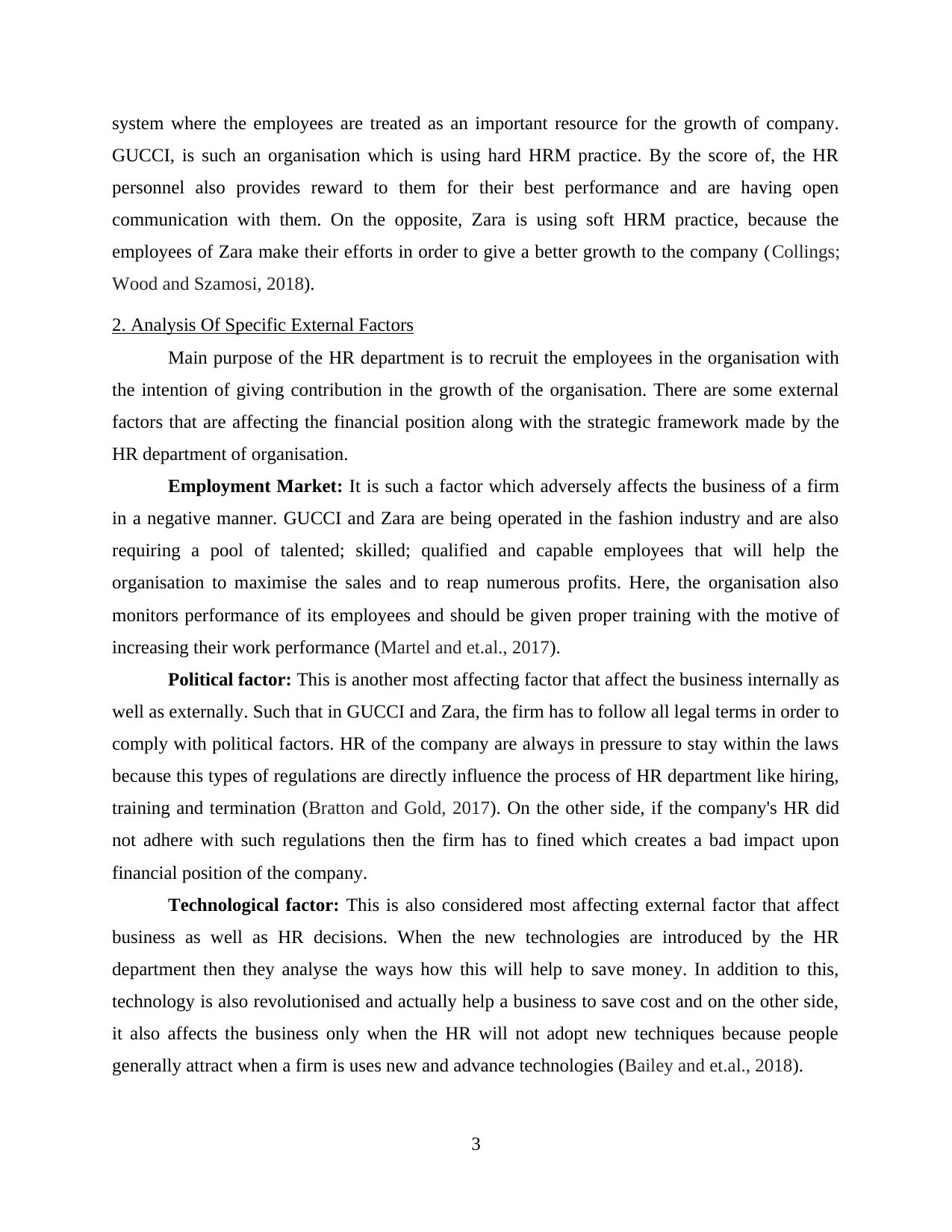
system where the employees are treated as an important resource for the growth of company.
GUCCI, is such an organisation which is using hard HRM practice. By the score of, the HR
personnel also provides reward to them for their best performance and are having open
communication with them. On the opposite, Zara is using soft HRM practice, because the
employees of Zara make their efforts in order to give a better growth to the company (Collings;
Wood and Szamosi, 2018).
2. Analysis Of Specific External Factors
Main purpose of the HR department is to recruit the employees in the organisation with
the intention of giving contribution in the growth of the organisation. There are some external
factors that are affecting the financial position along with the strategic framework made by the
HR department of organisation.
Employment Market: It is such a factor which adversely affects the business of a firm
in a negative manner. GUCCI and Zara are being operated in the fashion industry and are also
requiring a pool of talented; skilled; qualified and capable employees that will help the
organisation to maximise the sales and to reap numerous profits. Here, the organisation also
monitors performance of its employees and should be given proper training with the motive of
increasing their work performance (Martel and et.al., 2017).
Political factor: This is another most affecting factor that affect the business internally as
well as externally. Such that in GUCCI and Zara, the firm has to follow all legal terms in order to
comply with political factors. HR of the company are always in pressure to stay within the laws
because this types of regulations are directly influence the process of HR department like hiring,
training and termination (Bratton and Gold, 2017). On the other side, if the company's HR did
not adhere with such regulations then the firm has to fined which creates a bad impact upon
financial position of the company.
Technological factor: This is also considered most affecting external factor that affect
business as well as HR decisions. When the new technologies are introduced by the HR
department then they analyse the ways how this will help to save money. In addition to this,
technology is also revolutionised and actually help a business to save cost and on the other side,
it also affects the business only when the HR will not adopt new techniques because people
generally attract when a firm is uses new and advance technologies (Bailey and et.al., 2018).
3
GUCCI, is such an organisation which is using hard HRM practice. By the score of, the HR
personnel also provides reward to them for their best performance and are having open
communication with them. On the opposite, Zara is using soft HRM practice, because the
employees of Zara make their efforts in order to give a better growth to the company (Collings;
Wood and Szamosi, 2018).
2. Analysis Of Specific External Factors
Main purpose of the HR department is to recruit the employees in the organisation with
the intention of giving contribution in the growth of the organisation. There are some external
factors that are affecting the financial position along with the strategic framework made by the
HR department of organisation.
Employment Market: It is such a factor which adversely affects the business of a firm
in a negative manner. GUCCI and Zara are being operated in the fashion industry and are also
requiring a pool of talented; skilled; qualified and capable employees that will help the
organisation to maximise the sales and to reap numerous profits. Here, the organisation also
monitors performance of its employees and should be given proper training with the motive of
increasing their work performance (Martel and et.al., 2017).
Political factor: This is another most affecting factor that affect the business internally as
well as externally. Such that in GUCCI and Zara, the firm has to follow all legal terms in order to
comply with political factors. HR of the company are always in pressure to stay within the laws
because this types of regulations are directly influence the process of HR department like hiring,
training and termination (Bratton and Gold, 2017). On the other side, if the company's HR did
not adhere with such regulations then the firm has to fined which creates a bad impact upon
financial position of the company.
Technological factor: This is also considered most affecting external factor that affect
business as well as HR decisions. When the new technologies are introduced by the HR
department then they analyse the ways how this will help to save money. In addition to this,
technology is also revolutionised and actually help a business to save cost and on the other side,
it also affects the business only when the HR will not adopt new techniques because people
generally attract when a firm is uses new and advance technologies (Bailey and et.al., 2018).
3
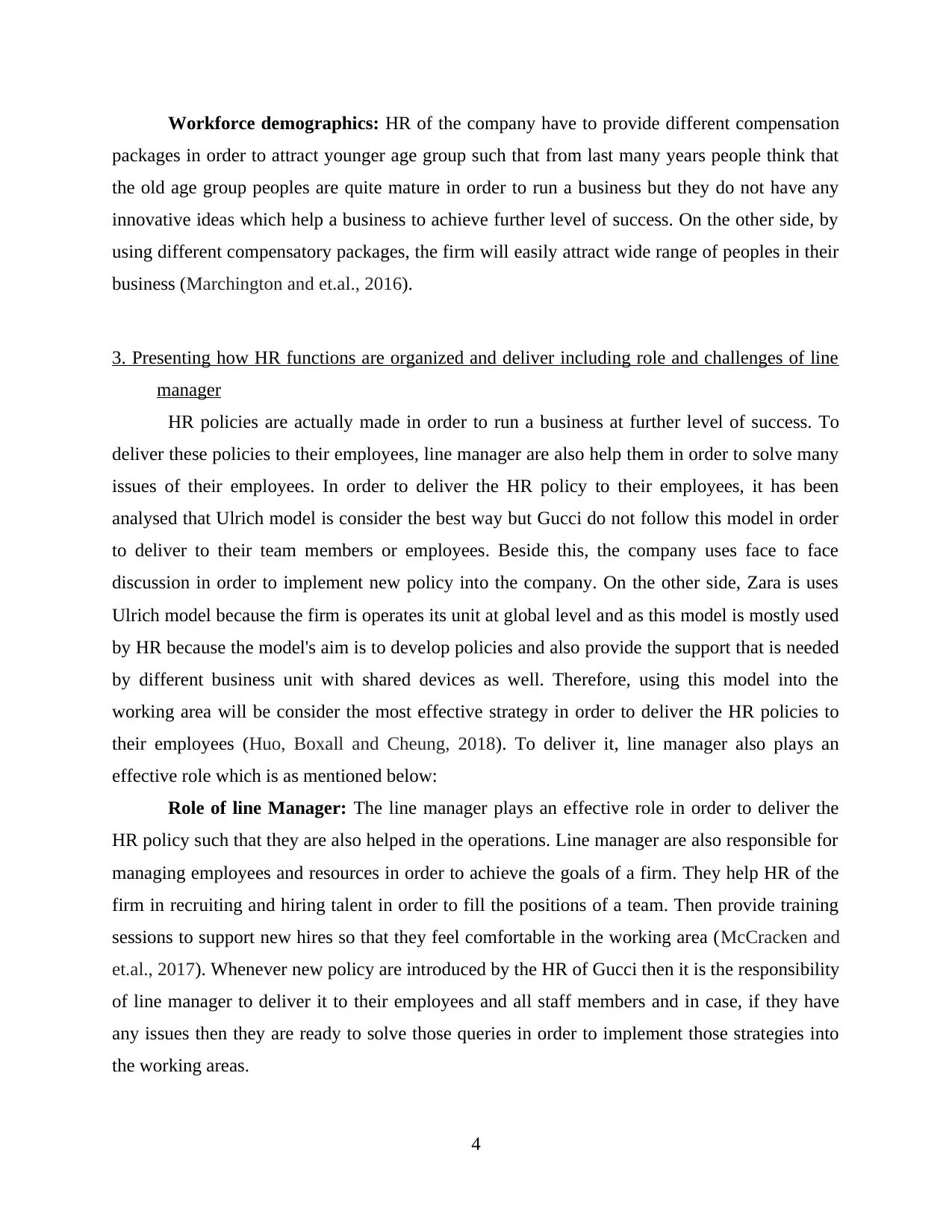
Workforce demographics: HR of the company have to provide different compensation
packages in order to attract younger age group such that from last many years people think that
the old age group peoples are quite mature in order to run a business but they do not have any
innovative ideas which help a business to achieve further level of success. On the other side, by
using different compensatory packages, the firm will easily attract wide range of peoples in their
business (Marchington and et.al., 2016).
3. Presenting how HR functions are organized and deliver including role and challenges of line
manager
HR policies are actually made in order to run a business at further level of success. To
deliver these policies to their employees, line manager are also help them in order to solve many
issues of their employees. In order to deliver the HR policy to their employees, it has been
analysed that Ulrich model is consider the best way but Gucci do not follow this model in order
to deliver to their team members or employees. Beside this, the company uses face to face
discussion in order to implement new policy into the company. On the other side, Zara is uses
Ulrich model because the firm is operates its unit at global level and as this model is mostly used
by HR because the model's aim is to develop policies and also provide the support that is needed
by different business unit with shared devices as well. Therefore, using this model into the
working area will be consider the most effective strategy in order to deliver the HR policies to
their employees (Huo, Boxall and Cheung, 2018). To deliver it, line manager also plays an
effective role which is as mentioned below:
Role of line Manager: The line manager plays an effective role in order to deliver the
HR policy such that they are also helped in the operations. Line manager are also responsible for
managing employees and resources in order to achieve the goals of a firm. They help HR of the
firm in recruiting and hiring talent in order to fill the positions of a team. Then provide training
sessions to support new hires so that they feel comfortable in the working area (McCracken and
et.al., 2017). Whenever new policy are introduced by the HR of Gucci then it is the responsibility
of line manager to deliver it to their employees and all staff members and in case, if they have
any issues then they are ready to solve those queries in order to implement those strategies into
the working areas.
4
packages in order to attract younger age group such that from last many years people think that
the old age group peoples are quite mature in order to run a business but they do not have any
innovative ideas which help a business to achieve further level of success. On the other side, by
using different compensatory packages, the firm will easily attract wide range of peoples in their
business (Marchington and et.al., 2016).
3. Presenting how HR functions are organized and deliver including role and challenges of line
manager
HR policies are actually made in order to run a business at further level of success. To
deliver these policies to their employees, line manager are also help them in order to solve many
issues of their employees. In order to deliver the HR policy to their employees, it has been
analysed that Ulrich model is consider the best way but Gucci do not follow this model in order
to deliver to their team members or employees. Beside this, the company uses face to face
discussion in order to implement new policy into the company. On the other side, Zara is uses
Ulrich model because the firm is operates its unit at global level and as this model is mostly used
by HR because the model's aim is to develop policies and also provide the support that is needed
by different business unit with shared devices as well. Therefore, using this model into the
working area will be consider the most effective strategy in order to deliver the HR policies to
their employees (Huo, Boxall and Cheung, 2018). To deliver it, line manager also plays an
effective role which is as mentioned below:
Role of line Manager: The line manager plays an effective role in order to deliver the
HR policy such that they are also helped in the operations. Line manager are also responsible for
managing employees and resources in order to achieve the goals of a firm. They help HR of the
firm in recruiting and hiring talent in order to fill the positions of a team. Then provide training
sessions to support new hires so that they feel comfortable in the working area (McCracken and
et.al., 2017). Whenever new policy are introduced by the HR of Gucci then it is the responsibility
of line manager to deliver it to their employees and all staff members and in case, if they have
any issues then they are ready to solve those queries in order to implement those strategies into
the working areas.
4
⊘ This is a preview!⊘
Do you want full access?
Subscribe today to unlock all pages.

Trusted by 1+ million students worldwide
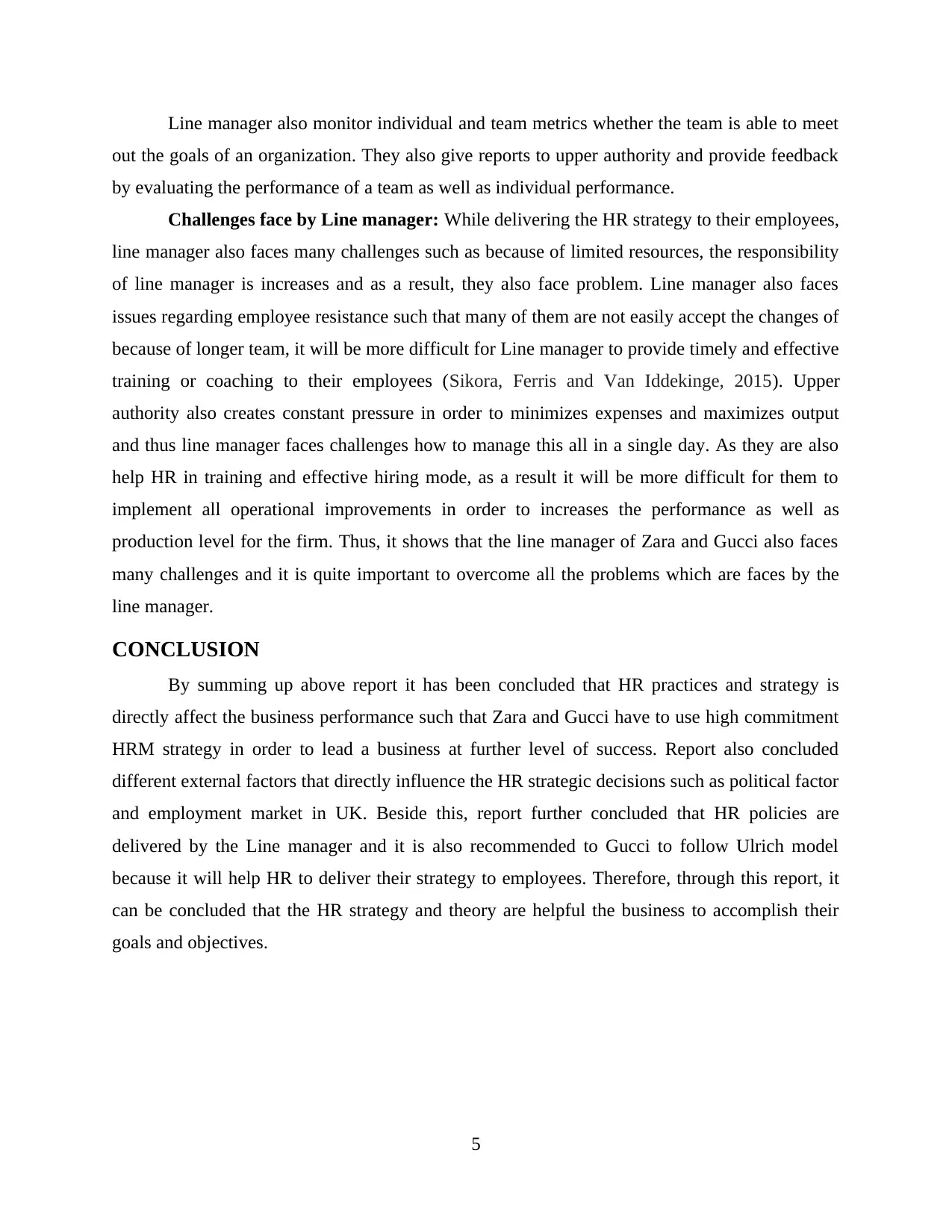
Line manager also monitor individual and team metrics whether the team is able to meet
out the goals of an organization. They also give reports to upper authority and provide feedback
by evaluating the performance of a team as well as individual performance.
Challenges face by Line manager: While delivering the HR strategy to their employees,
line manager also faces many challenges such as because of limited resources, the responsibility
of line manager is increases and as a result, they also face problem. Line manager also faces
issues regarding employee resistance such that many of them are not easily accept the changes of
because of longer team, it will be more difficult for Line manager to provide timely and effective
training or coaching to their employees (Sikora, Ferris and Van Iddekinge, 2015). Upper
authority also creates constant pressure in order to minimizes expenses and maximizes output
and thus line manager faces challenges how to manage this all in a single day. As they are also
help HR in training and effective hiring mode, as a result it will be more difficult for them to
implement all operational improvements in order to increases the performance as well as
production level for the firm. Thus, it shows that the line manager of Zara and Gucci also faces
many challenges and it is quite important to overcome all the problems which are faces by the
line manager.
CONCLUSION
By summing up above report it has been concluded that HR practices and strategy is
directly affect the business performance such that Zara and Gucci have to use high commitment
HRM strategy in order to lead a business at further level of success. Report also concluded
different external factors that directly influence the HR strategic decisions such as political factor
and employment market in UK. Beside this, report further concluded that HR policies are
delivered by the Line manager and it is also recommended to Gucci to follow Ulrich model
because it will help HR to deliver their strategy to employees. Therefore, through this report, it
can be concluded that the HR strategy and theory are helpful the business to accomplish their
goals and objectives.
5
out the goals of an organization. They also give reports to upper authority and provide feedback
by evaluating the performance of a team as well as individual performance.
Challenges face by Line manager: While delivering the HR strategy to their employees,
line manager also faces many challenges such as because of limited resources, the responsibility
of line manager is increases and as a result, they also face problem. Line manager also faces
issues regarding employee resistance such that many of them are not easily accept the changes of
because of longer team, it will be more difficult for Line manager to provide timely and effective
training or coaching to their employees (Sikora, Ferris and Van Iddekinge, 2015). Upper
authority also creates constant pressure in order to minimizes expenses and maximizes output
and thus line manager faces challenges how to manage this all in a single day. As they are also
help HR in training and effective hiring mode, as a result it will be more difficult for them to
implement all operational improvements in order to increases the performance as well as
production level for the firm. Thus, it shows that the line manager of Zara and Gucci also faces
many challenges and it is quite important to overcome all the problems which are faces by the
line manager.
CONCLUSION
By summing up above report it has been concluded that HR practices and strategy is
directly affect the business performance such that Zara and Gucci have to use high commitment
HRM strategy in order to lead a business at further level of success. Report also concluded
different external factors that directly influence the HR strategic decisions such as political factor
and employment market in UK. Beside this, report further concluded that HR policies are
delivered by the Line manager and it is also recommended to Gucci to follow Ulrich model
because it will help HR to deliver their strategy to employees. Therefore, through this report, it
can be concluded that the HR strategy and theory are helpful the business to accomplish their
goals and objectives.
5
Paraphrase This Document
Need a fresh take? Get an instant paraphrase of this document with our AI Paraphraser
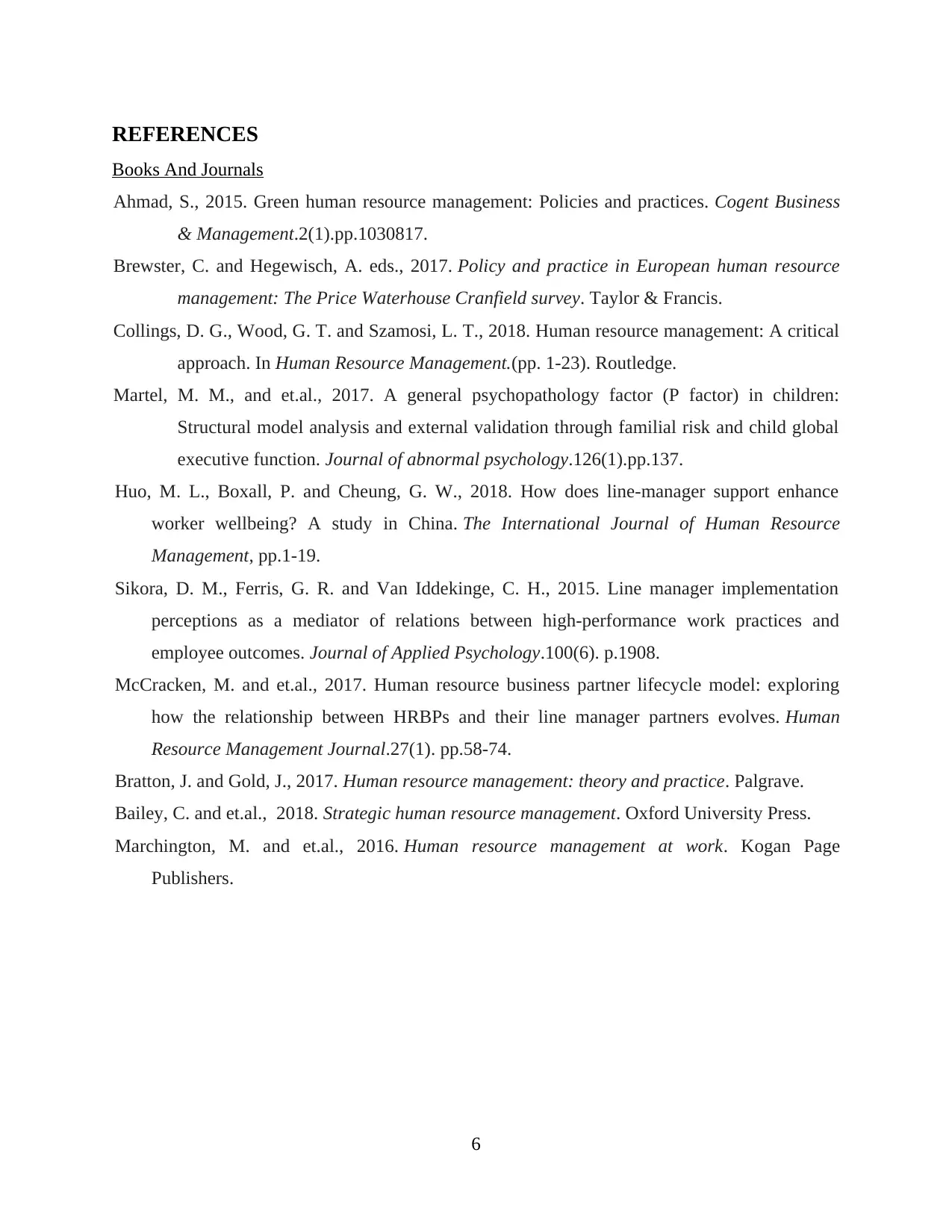
REFERENCES
Books And Journals
Ahmad, S., 2015. Green human resource management: Policies and practices. Cogent Business
& Management.2(1).pp.1030817.
Brewster, C. and Hegewisch, A. eds., 2017. Policy and practice in European human resource
management: The Price Waterhouse Cranfield survey. Taylor & Francis.
Collings, D. G., Wood, G. T. and Szamosi, L. T., 2018. Human resource management: A critical
approach. In Human Resource Management.(pp. 1-23). Routledge.
Martel, M. M., and et.al., 2017. A general psychopathology factor (P factor) in children:
Structural model analysis and external validation through familial risk and child global
executive function. Journal of abnormal psychology.126(1).pp.137.
Huo, M. L., Boxall, P. and Cheung, G. W., 2018. How does line-manager support enhance
worker wellbeing? A study in China. The International Journal of Human Resource
Management, pp.1-19.
Sikora, D. M., Ferris, G. R. and Van Iddekinge, C. H., 2015. Line manager implementation
perceptions as a mediator of relations between high-performance work practices and
employee outcomes. Journal of Applied Psychology.100(6). p.1908.
McCracken, M. and et.al., 2017. Human resource business partner lifecycle model: exploring
how the relationship between HRBPs and their line manager partners evolves. Human
Resource Management Journal.27(1). pp.58-74.
Bratton, J. and Gold, J., 2017. Human resource management: theory and practice. Palgrave.
Bailey, C. and et.al., 2018. Strategic human resource management. Oxford University Press.
Marchington, M. and et.al., 2016. Human resource management at work. Kogan Page
Publishers.
6
Books And Journals
Ahmad, S., 2015. Green human resource management: Policies and practices. Cogent Business
& Management.2(1).pp.1030817.
Brewster, C. and Hegewisch, A. eds., 2017. Policy and practice in European human resource
management: The Price Waterhouse Cranfield survey. Taylor & Francis.
Collings, D. G., Wood, G. T. and Szamosi, L. T., 2018. Human resource management: A critical
approach. In Human Resource Management.(pp. 1-23). Routledge.
Martel, M. M., and et.al., 2017. A general psychopathology factor (P factor) in children:
Structural model analysis and external validation through familial risk and child global
executive function. Journal of abnormal psychology.126(1).pp.137.
Huo, M. L., Boxall, P. and Cheung, G. W., 2018. How does line-manager support enhance
worker wellbeing? A study in China. The International Journal of Human Resource
Management, pp.1-19.
Sikora, D. M., Ferris, G. R. and Van Iddekinge, C. H., 2015. Line manager implementation
perceptions as a mediator of relations between high-performance work practices and
employee outcomes. Journal of Applied Psychology.100(6). p.1908.
McCracken, M. and et.al., 2017. Human resource business partner lifecycle model: exploring
how the relationship between HRBPs and their line manager partners evolves. Human
Resource Management Journal.27(1). pp.58-74.
Bratton, J. and Gold, J., 2017. Human resource management: theory and practice. Palgrave.
Bailey, C. and et.al., 2018. Strategic human resource management. Oxford University Press.
Marchington, M. and et.al., 2016. Human resource management at work. Kogan Page
Publishers.
6
1 out of 8
Related Documents
Your All-in-One AI-Powered Toolkit for Academic Success.
+13062052269
info@desklib.com
Available 24*7 on WhatsApp / Email
![[object Object]](/_next/static/media/star-bottom.7253800d.svg)
Unlock your academic potential
Copyright © 2020–2025 A2Z Services. All Rights Reserved. Developed and managed by ZUCOL.





